TP-Link Omada OC200 User manual

User Guide
Omada Cloud Controller
OC200
1910012442 REV 1.0.0
September 2018
|
CONTENTS |
|
1 Quick Start........................................................................................................................ |
1 |
|
1.1 |
Deploy the OC200........................................................................................................................................................ |
2 |
|
1.1.1 Deploy the OC200 and EAPs in the Same Subnet.................................................................................. |
2 |
|
1.1.2 Deploy the OC200 and EAPs in Different Subnets................................................................................. |
2 |
1.2 |
Determine the Management Method.................................................................................................................... |
4 |
|
1.2.1 Management on the Local Network.............................................................................................................. |
4 |
|
1.2.2 Management via Cloud Access...................................................................................................................... |
4 |
1.3 |
Inform the EAPs of the OC200's Address............................................................................................................ |
5 |
1.4 |
Log in to OC200............................................................................................................................................................. |
7 |
|
1.4.1 On the Local Network......................................................................................................................................... |
7 |
|
1.4.2 Via Omada Cloud.................................................................................................................................................. |
7 |
|
1.4.3 Do the Basic Configurations............................................................................................................................ |
7 |
|
1.4.4 Log In to the Management Interface......................................................................................................... |
10 |
1.5 |
Create Sites and Adopt EAPs................................................................................................................................ |
11 |
|
1.5.1 Create Sites......................................................................................................................................................... |
11 |
|
1.5.2 Adopt the EAPs.................................................................................................................................................. |
11 |
1.6 |
Monitor and Manage the EAPs.............................................................................................................................. |
12 |
2 Monitor and Manage the Network......................................................................... |
14 |
|
2.1 |
Monitor the Network with the Map...................................................................................................................... |
15 |
|
2.1.1 Add a Map............................................................................................................................................................ |
15 |
|
2.1.2 Monitor the EAPs on the Map....................................................................................................................... |
17 |
2.2 |
View the Statistics of the Network...................................................................................................................... |
18 |
|
2.2.1 View the Client Distribution on SSID.......................................................................................................... |
18 |
|
2.2.2 Have a Quick Look at EAPs and Clients.................................................................................................... |
18 |
|
2.2.3 View Current Usage-Top EAPs.................................................................................................................... |
19 |
|
2.2.4 View Recent Activities..................................................................................................................................... |
19 |
2.3 |
Monitor and Manage the EAPs.............................................................................................................................. |
20 |
|
2.3.1 Manage the EAPs in Different Status........................................................................................................ |
20 |
|
2.3.2 View the Detailed Information of EAPs..................................................................................................... |
21 |
|
2.3.3 Manage the EAPs in the Action Column................................................................................................... |
22 |
2.4 |
Monitor and Manage Clients.................................................................................................................................. |
23 |
|
2.4.1 View the Current Information of Clients................................................................................................... |
23 |
|
2.4.2 Manage Clients in the Action Column....................................................................................................... |
24 |
2.5 |
View Clients Statistics During the Specified Period .................................................................................... |
24 |
|
2.5.1 Select a Specified Period............................................................................................................................... |
24 |
|
2.5.2 View the History Information of Clients.................................................................................................... |
25 |
|
2.5.3 Manage Clients in the Action Column....................................................................................................... |
25 |
2.6 |
Manage the Rogue APs List................................................................................................................................... |
26 |
|
2.6.1 Manage the Untrusted Rogue APs List..................................................................................................... |
26 |
|
2.6.2 Manage the Trusted Rogue APs List......................................................................................................... |
26 |
2.7 |
View Past Guest Authorization............................................................................................................................. |
27 |
2.8 |
View Logs..................................................................................................................................................................... |
28 |
2.9 |
View Alerts................................................................................................................................................................... |
28 |
3 Configure the EAPs Globally.................................................................................... |
29 |
|
3.1 |
Wireless Network...................................................................................................................................................... |
30 |
|
3.1.1 Add Wireless Networks................................................................................................................................... |
30 |
|
3.1.2 Configure Advanced Wireless Parameters............................................................................................. |
35 |
|
3.1.3 Configure Band Steering................................................................................................................................ |
37 |
|
3.1.4 Configure Mesh................................................................................................................................................. |
38 |
3.2 |
Access Control........................................................................................................................................................... |
42 |
3.3 |
Portal Authentication............................................................................................................................................... |
43 |
|
3.3.1 No Authentication............................................................................................................................................. |
44 |
|
3.3.2 Simple Password............................................................................................................................................... |
48 |
|
3.3.3 Local User............................................................................................................................................................ |
52 |
|
3.3.4 Voucher................................................................................................................................................................. |
59 |
|
3.3.5 SMS........................................................................................................................................................................ |
67 |
|
3.3.6 Facebook.............................................................................................................................................................. |
72 |
|
3.3.7 External RADIUS Server.................................................................................................................................. |
73 |
|
3.3.8 External Portal Server...................................................................................................................................... |
78 |
3.4 |
Free Authentication Policy..................................................................................................................................... |
79 |
3.5 |
MAC Filter..................................................................................................................................................................... |
80 |
3.6 |
Scheduler..................................................................................................................................................................... |
82 |
3.7 |
QoS................................................................................................................................................................................. |
84 |
3.8 |
Site Settings ............................................................................................................................................................... |
87 |
|
3.8.1 LED.......................................................................................................................................................................... |
87 |
|
3.8.2 Device Account.................................................................................................................................................. |
88 |
|
3.8.3 Reboot Schedule............................................................................................................................................... |
88 |
|
3.8.4 Log Settings........................................................................................................................................................ |
89 |
|
3.8.5 Batch Upgrade................................................................................................................................................... |
90 |
|
3.8.6 SSH......................................................................................................................................................................... |
92 |
|
3.8.7 Management VLAN.......................................................................................................................................... |
93 |
4 Omada Cloud Service................................................................................................. |
94 |
|
4.1 |
Configure the Cloud Access.................................................................................................................................. |
95 |
|
4.1.1 Enable Cloud Access....................................................................................................................................... |
95 |
|
4.1.2 Manage the Cloud Users................................................................................................................................ |
95 |
4.2 |
Manage the OC200 via Omada Cloud................................................................................................................ |
97 |
|
4.2.1 Access the OC200 via Omada Cloud........................................................................................................ |
98 |
|
4.2.2 Change your TP-Link ID information........................................................................................................ |
100 |
5 Configure the EAPs Separately........................................................................... |
101 |
|
5.1 |
View the Information of the EAP....................................................................................................................... |
102 |
|
5.1.1 Overview............................................................................................................................................................. |
102 |
|
5.1.2 LAN....................................................................................................................................................................... |
102 |
|
5.1.3 Radio.................................................................................................................................................................... |
103 |
5.2 |
View Clients Connecting to the EAP................................................................................................................ |
103 |
|
5.2.1 User...................................................................................................................................................................... |
103 |
|
5.2.2 Guest.................................................................................................................................................................... |
104 |
5.3 |
View Mesh Information of the EAP................................................................................................................... |
104 |
|
5.3.1 Uplinks................................................................................................................................................................. |
104 |
|
5.3.2 Downlinks........................................................................................................................................................... |
105 |
5.4 |
Configure the EAP.................................................................................................................................................. |
105 |
|
5.4.1 Basic Config...................................................................................................................................................... |
105 |
|
5.4.2 IP Setting............................................................................................................................................................ |
106 |
|
5.4.3 Radio.................................................................................................................................................................... |
107 |
|
5.4.4 Load Balance.................................................................................................................................................... |
108 |
|
5.4.5 WLANs................................................................................................................................................................. |
109 |
|
5.4.6 Trunk Settings.................................................................................................................................................. |
109 |
|
5.4.7 Rogue AP Detection....................................................................................................................................... |
110 |
|
5.4.8 Local LAN Port Settings (Only for EAP115-Wall and EAP225-Wall)............................................ |
110 |
|
5.4.9 Forget this AP................................................................................................................................................... |
111 |
6 Manage the OC200................................................................................................... |
112 |
|
6.1 |
Status.......................................................................................................................................................................... |
113 |
6.2 |
User Account............................................................................................................................................................ |
113 |
6.3 |
General Setting........................................................................................................................................................ |
114 |
|
6.3.1 Configure Basic Settings.............................................................................................................................. |
115 |
|
6.3.2 Configure Network Settings....................................................................................................................... |
115 |
|
6.3.3 Configure Mail Server.................................................................................................................................... |
116 |
6.4 |
History Data Retention......................................................................................................................................... |
117 |
6.5 |
Backup&Restore..................................................................................................................................................... |
118 |
6.6 |
Auto Backup............................................................................................................................................................. |
119 |
6.7 |
Maintenance............................................................................................................................................................. |
121 |
7 Application Example................................................................................................ |
122 |
|
7.1 |
Basic Configuration............................................................................................................................................... |
123 |
7.2 |
Advanced Settings................................................................................................................................................. |
123 |
|
7.2.1 Monitor the EAPs with Map......................................................................................................................... |
123 |
7.2.2 Configure Portal Authentication................................................................................................................ |
124 |
7.2.3 Create a SSID for the Employees.............................................................................................................. |
126 |
7.2.4 Configure Scheduler...................................................................................................................................... |
127 |

1 Quick Start
OC200 is a hardware Omada Cloud Controller, which is running with a built-in software controller. OC200 can manage multiple EAPs centrally just as the software controller does. The difference is that the software controller needs to run in a management host, which is unnecessary for OC200. You just need to pre-configure the OC200, then keep it running in your network.
Follow the steps below to complete the basic settings of OC200.
·Deploy the OC200
·Determine the Management Method
·Inform the EAPs of the OC200's Address
·Log in to OC200
· Create Sites and Adopt EAPs
·Monitor and Manage the EAPs
1
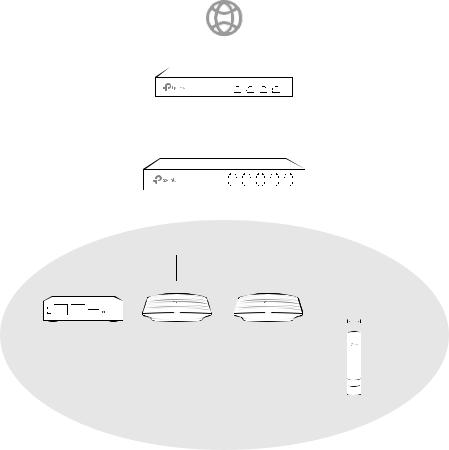
1.1 Deploy the OC200
There are two kinds of network topologies which are suitable for OC200 deployment:
·The OC200 and EAPs are in the same subnet.
·The OC200 and EAPs are in different subnets.
Determine your topology according to your need and refer to the following introductions to build your network topology.
1.1.1 Deploy the OC200 and EAPs in the Same Subnet
If your need to deploy the OC200 and EAPs in the same subnet, refer to the following network topology.
A router acts as a DHCP server to assign IP addresses to EAPs, clients and OC200. The OC200 and the EAPs are in the same subnet.
Router
Layer 2 Switch
|
|
|
|
|
|
|
|
|
|
|
|
|
|
|
|
|
|
|
|
|
|
|
|
|
|
|
|
|
|
|
|
|
|
|
|
|
|
|
|
|
|
|
|
|
|
|
|
|
|
|
|
|
|
|
OC200 |
|
|
|
EAP |
|
EAP |
|
|||
IP: 192.168.0.100/24
EAP
Subnet: 192.168.0.0/24
1.1.2 Deploy the OC200 and EAPs in Different Subnets
If your need to deploy the OC200 and EAPs in different subnets, refer to the following network topology.
2
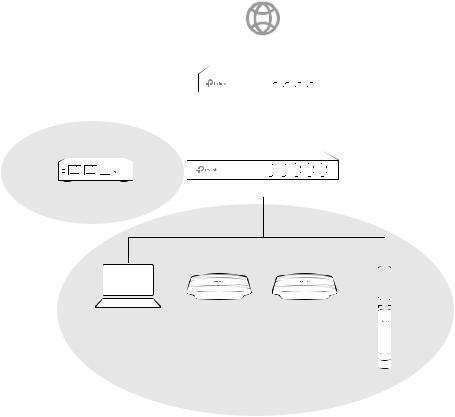
A router acts as the gateway of the network. A layer 3 switch acts as a DHCP server to assign IP addresses to EAPs, OC200 and clients. The EAPs are in subet 1, of which the IP network segment is 192.168.0.0/24; the OC200 is in subnet 2, of which the IP network segment is 192.168.1.0/24.
For the EAPs and the OC200 are in the different networksegment, the EAPs cannot find the OC200 directly. To help the EAPs find the OC200, you need to install an Omada Discover Utility on a host which is in the same subnet with the EAPs. For how to use Omada Discovery Utility, refer to Inform the EAPs of the OC200’s Address.
Router
Subnet 2: 192.168.1.0/24
|
|
|
OC200 |
Layer 3 Switch |
|
IP:
Omada
Discovery Utility
Host A |
EAP |
EAP |
|
IP: 192.168.0.100/24
Subnet 1: 192.168.0.0/24 |
EAP |
|
3
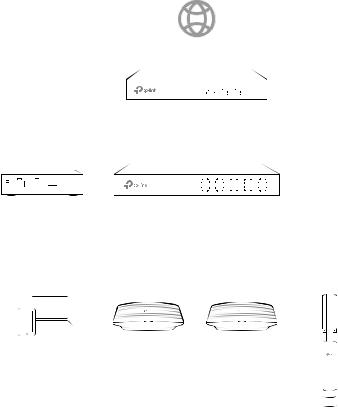
1.2 Determine the Management Method
OC200 supports two flexible management methods to centrally manage EAPs:
·Management on the local network
·Management via Cloud Access
Determine your management method according to your need and refer to the following introductions to build your network toplogy.
1.2.1 Management on the Local Network
To manage EAPs locally, please deploy your management host on the local network. The following topology is an example for the deployment of the management host. As long as there is a route for the management host to access the OC200, the management host can log in to the OC200 to manage the EAPs. For how to log in to the OC200, please refer toOn the Local Network.
Router
|
|
|
|
|
|
|
|
|
|
|
|
|
|
|
|
|
|
|
|
OC200 |
|
Switch |
|||||||||||||||
|
|
|
|
|
|
|
|
|
|
|
|
|
|
|
|
|
|
|
|
|
|
|
|
|
|
|
|
|
|
|
|
|
|
|
|
|
|
|
|
|
|
|
|
|
|
|
|
|
|
|
|
|
|
|
|
|
|
|
|
|
|
|
|
|
|
|
|
|
|
|
|
|
|
|
|
|
|
|
|
|
|
|
|
|
|
|
|
|
|
|
|
|
|
|
|
|
|
|
|
|
|
|
|
|
|
|
|
|
|
|
|
|
|
|
|
|
|
|
|
|
|
|
|
|
|
|
|
|
|
|
|
|
Management Device |
EAP |
EAP |
EAP
1.2.2 Management via Cloud Access
If you need to manage EAPs remotely, for example, your EAPs are in your office but you want to manage them at home, you can manage the EAPs via cloud access.
4
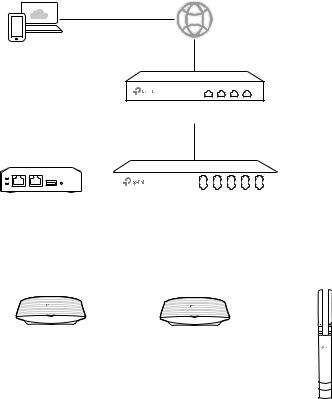
The following topology is a typical example. You just need to deploy your OC200 and EAPs on your local network, and use a management device to control them remotely. On the management device, you can open a web browser to remotely launch the OC200 via Omada Cloud. For more details about Cloud Access, refer toOmada Cloud Service.
Management Device
Router
|
|
|
|
|
|
|
|
|
|
|
|
|
|
|
|
|
|
|
|
|
|
|
|
|
|
|
|
|
|
|
|
|
|
|
|
|
|
|
|
|
|
|
|
|
|
|
|
|
|
|
|
|
|
|
|
|
|
|
|
|
|
|
|
OC200 |
|
Switch |
|||||||||||||
|
|
|
|
|
|
|
|
|
|
|
|
|
|
|
|
|
|
|
|
|
|
|
|
|
|
|
|
|
|
|
|
EAP |
EAP |
EAP
1.3 Inform the EAPs of the OC200's Address
If your OC200 and EAPs are in the same network subnet, you can skip this section.
If your OC200 and EAPs are in different subnets, you need to install Omada Discovery Utility on a host that is in the same network segment with the EAPs. Omada Discovery Utility can help EAPs find the OC200.
System Requirements
Windows 7/8/10/Server
Mac OS X 10.7/10.8/10.9/10.10/10.11
Install and Use Omada Discovery Utility
Follow the steps below to install Omada Discovery Utility and use it to inform the EAPs of the OC200's IP address:
5

1. Download the installation file from the website https://www.tp-link.com/en/download/EAP- Controller.html#EAP_Discovery_Tool. Then follow the instructions to properly install Omada Discovery Utility.
2. Open the Omada Discovery Utility and the following window will pop up. This window shows the information of all EAPs in the same LAN.
3. Click Manage in the Action column or select multiple EAPs and click Batch Setting.
4. Enter the hostname or IP address of the OC200.
5. Enter the EAP’s username and password (both are admin by default).
6. Click Apply to inform the EAP of the OC200’s hostname or IP address. And then the connection can be established between the EAP and the OC200.
6
1.4 Log in to OC200
To use OC200 to manage EAPs, you first need to log in to OC200. There are two situations:
·Login in to the OC200 on the local network
·Login in to the OC200 via Omada cloud
1.4.1 On the Local Network
Follow the steps below to enter the management interface of OC200 on the local network: 1. Make sure that your management device has the route to access the OC200.
2. Check the DHCP server (typically a router) for OC200’s IP Address. The default fallback IP of address OC 200 is 192.168.0.253.
Tips The fallback IP address is used when OC200 fails to get dynamic IP address from the DHCP server
3. Launch a web browser and type OC200’s IP address in the address bar, then press Enter (Windows) or Return (Mac).
1.4.2 Via Omada Cloud
Follow the steps below to log in to OC200 via Omada cloud:
1. Make sure that your management device and OC200 can access the internet.
2. Launch a web browser and visit https://omada.tplinkcloud.com in the address bar, then press Enter (Windows) or Return (Mac).
3. Enter your TP-Link ID and password to log in. Then click Add Cloud Controller and follow the instructions to add your OC200.
4. Click Launch in the Action column to visit the management interface of OC200.
1.4.3 Do the Basic Configurations
In the web browser you can see the configuration page. Follow the setup wizard to complete the basic settings for OC200.
7

1. Click Let’s Get Started.
2. Specify a name for OC200 and select the time zone. Click Next.
3. Specify a username and password for the login account. Specify the email address to receive the emails and reset your password if necessary. Click Next.
8
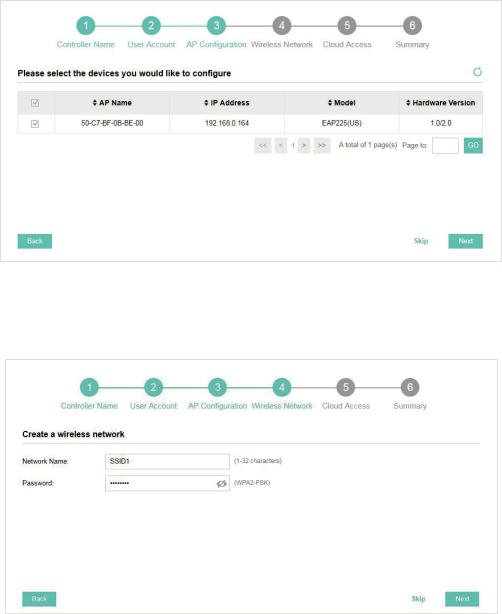
Note
After logging into OC200, set a mail server so that you can receive emails and reset your password in case that you forget the password. Please refer to Configure Mail Server.
4. The setup page displays all the detected EAPs in the network. Select one or more EAPs to be managed and click Next.
5. Set an SSID name (wireless network name) and password for the EAPs to be managed. OC200 will create two wireless networks, a 2.4GHz one and a 5GHz one, both encrypted in WPA2-PSK mode. Click Next.
6. If you want to manage EAPs via Omada cloud, enable the Cloud Access button, and bind your TP-Link ID to your OC200, and then click Next. If you want to manage EAPs on the local network, you can just click Skip. For more details about Omada Cloud, please refer to Omada Cloud
Service.
9
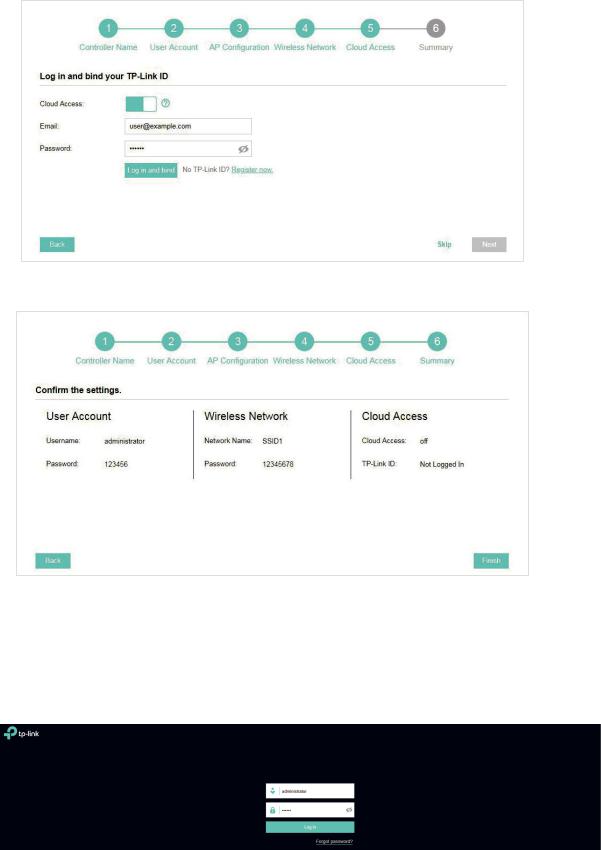
7. Review your settings and click Finish.
1.4.4 Log In to the Management Interface
Once the basic configurations are finished, the browser will be redirected to the following page. Log in to the management interface using the username and password you have set in the basic configurations.
10
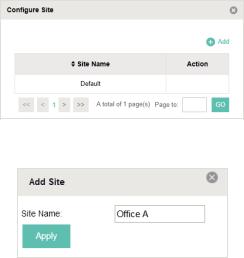
1.5 Create Sites and Adopt EAPs
OC200 can manage multiple EAP networks, which are called sites. Multiple sites are logically separated, and each site has its own configurations. There is an initial site named Default. If you have no need to manage EAPs with differnt sites, you can use the default site and skip the Create Sites section. However, Adopt the EAPs is a necessary step to manage the EAPs.
1.5.1 Create Sites
Follow the steps below to add sites.
1. Click  in the top left corner of the page and select
in the top left corner of the page and select  , and then the following window will pop up.
, and then the following window will pop up.
2. Click and set a name for the site.
and set a name for the site.
3. Click Apply to create the site.
1.5.2 Adopt the EAPs
OC200 can discover all EAP devices currently connected in the network and display their connection status. All EAPs are in Pending status when first discovered by OC200. To manage the EAPs, you need to adopt them. In the quick setup process, OC200 will automatically adopt the selected EAPs using the default username and password (both are admin). However, if you have changed the username or password of your EAPs before, OC200 cannot automatically adopt them, and you need to refer to the following steps to adopt them manually.
To ensure that all EAPs are adopted, follow the steps below:
1. Select a site and go to Access Points > Pending. The table displays all the EAPs that have not been adopted.
11
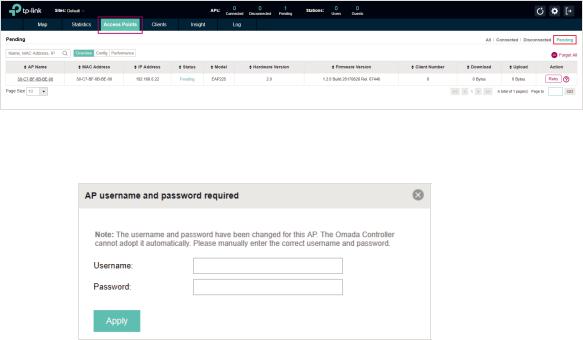
2. Click the Retry button in the Action column and enter the current username and password of the EAP. Click Apply.
Tips
··If you have a new discovered EAP, you can click the Adopt button in the Action column to adopt the EAP. OC200 will automatically adopt the EAP using the default username and password (both are admin).
··If you have multiple new discovered EAPs, and all of them have the default username and password (both are admin), you can click the Batch Adopt button to adopt them in batch. But if there are any EAPs with the Retry button, it means that the username and password of these EAPs have been changed. You need to first adopt them before batch adopt the rest EAPs.
3. After EAPs are adopted, the status will change from Pending to Connected. All the EAPs’ username and password will become the same as those of the OC200's administrator account you created in the Basic Configuration.
Tips
If you want to change the EAPs' username and password, refer to Device Account.
1.6 Monitor and Manage the EAPs
When all the configurations above are finished, you can centrally monitor and manage the EAPs via the OC200's management interface. The management interface is divided into three sections as the following figure shows.
12
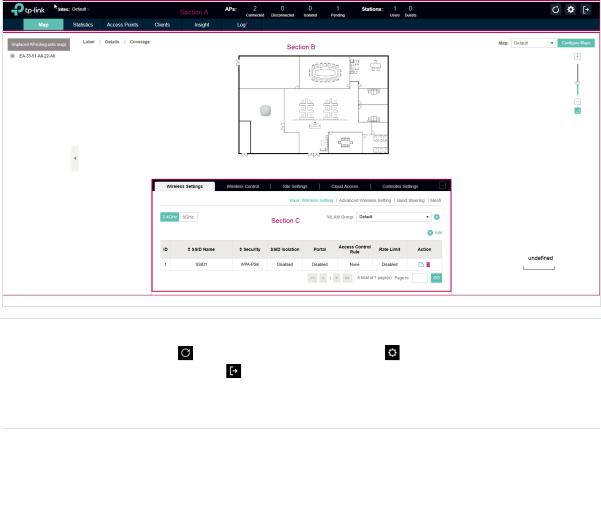
Section A |
In Section A, you can check the status of EAPs and clients in the network. Also, you |
|||
|
can click |
to refresh the current page, click |
to globally configure the wireless |
|
|
network, and click |
to sign out from the management interface. |
||
Furthermore, the Sites allows you to group your EAPs and manage them in batches. To configure sites, refer to Create Sites.
|
Section B |
In Section B, you can centrally monitor and manage the EAPs and clients. |
|
|
|
|
|
|
Section C |
In Section C, you can globally configure the wireless network. The global |
|
|
|
configurations will take effect on all the adopted EAPs. |
|
13

2 Monitor and Manage the Network
With OC200 you can monitor the EAP devices and centrally manage your wireless network. This chapter includes the following sections:
·Monitor the Network with the Map
·View the Statistics of the Network
·Monitor and Manage the EAPs
·Monitor and Manage Clients
·View Clients Statistics during the Specified Period
·Manage the Rogue APs List
·View Past Guest Authorization
·View Logs
·View Alerts
14
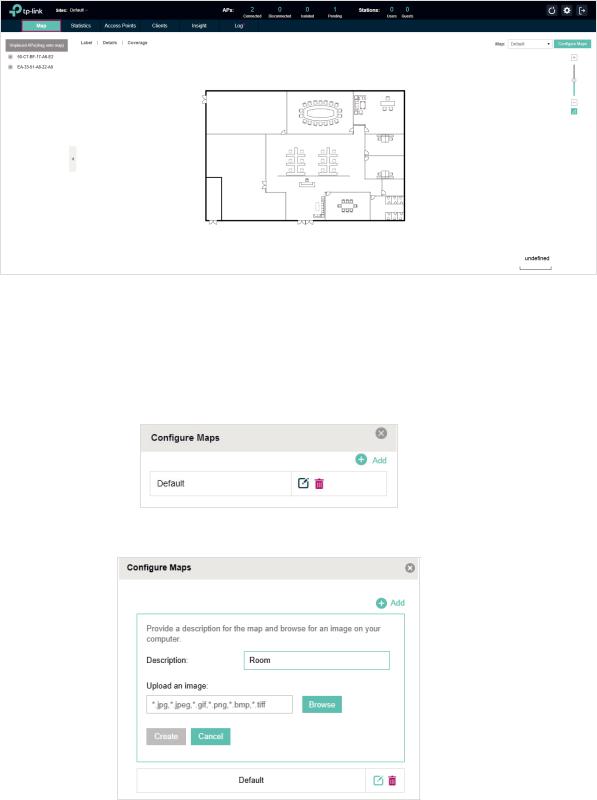
2.1 Monitor the Network with the Map
You can upload your local map images and monitor the status and coverage range of each EAP with the map. When you initially launch OC200, a default map is displayed as the following figure shows. Follow the instructions below to add your own map and manage the EAPs via the map.
2.1.1 Add a Map
Prepare a map image in .jpg, .jpeg, .gif, .png, .bmp, .tiff format. And then follow the steps below to add the map to the OC200.
1. Click Configure Maps on the upper right corner of map and click Add.
2. Enter the map description, select your map image, and click Create.
15
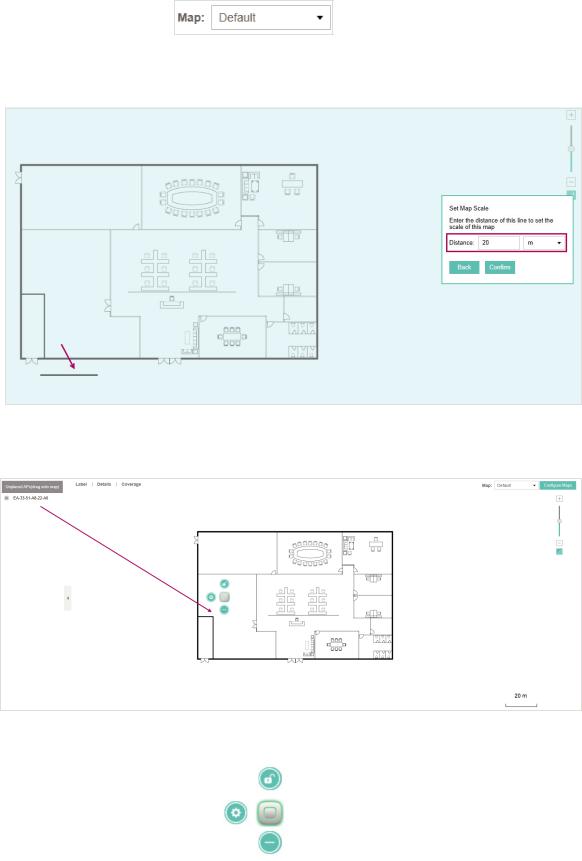
3. Select your local map from the drop-down list on the upper right corner of map area.
4. Click . Draw a line on the map and enter the distance the line represents. Then the OC200 will compute and generate the map scale automatically based on your configuration.
. Draw a line on the map and enter the distance the line represents. Then the OC200 will compute and generate the map scale automatically based on your configuration.
5. Drag the EAPs from the Unplaced APs list to the appropriate locations on the map according to their actual locations.
You can click  to reveal additional options:
to reveal additional options:
16
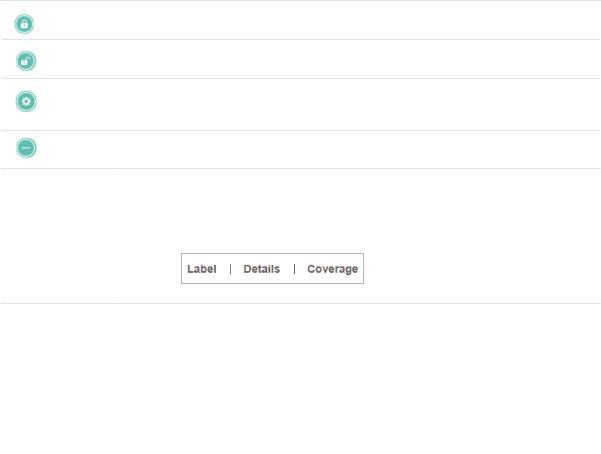
Lock the selected EAP in the current location on the map.
Unlock the selected EAP and you can drag it to another location.
Display the EAP's details and configure the wireless parameters. Refer to Configure the EAPs Separately.
Remove the selected EAP back into the Unplaced APs list.
2.1.2 Monitor the EAPs on the Map
Click any of the following options to display EAP Label, Details, and Coverage on the map.
|
Label |
Display the EAP’s name. The default name is the MAC address of the EAP. |
|
|
|
|
|
|
Details |
Display the EAP’s name, MAC address, IP address, transmitting/receiving channel, |
|
|
|
number of connected users, and number of connected guests. |
|
|
Coverage |
Display a visual representation of the wireless range covered by EAPs. The actual |
|
|
|
signal coverage may be smaller than the visual coverage on the map because the |
|
|
|
obstacles around the EAPs will weaken the signal. |
|
17
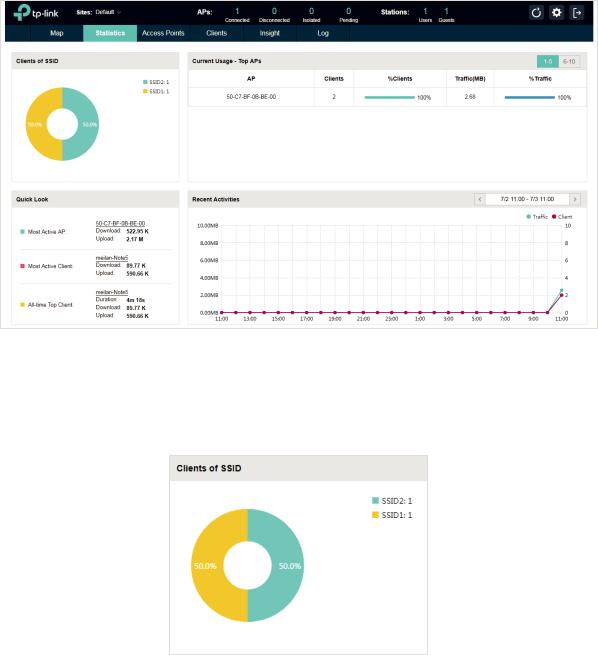
2.2 View the Statistics of the Network
OC200 collects all statistics of the managed EAPs and displays the statistical information via graphs, pie charts and tables, providing an overview of your wireless network.
2.2.1 View the Client Distribution on SSID
A visual pie chart shows the client distribution on each SSID. For example, the SSID1 has one client, which occupies 50% of all the clients.
2.2.2 Have a Quick Look at EAPs and Clients
This tab displays the Most Active AP, the Most Active Clients and the All-Time Top Client. You can click the MAC address of the EAP or the client to see more details.
18
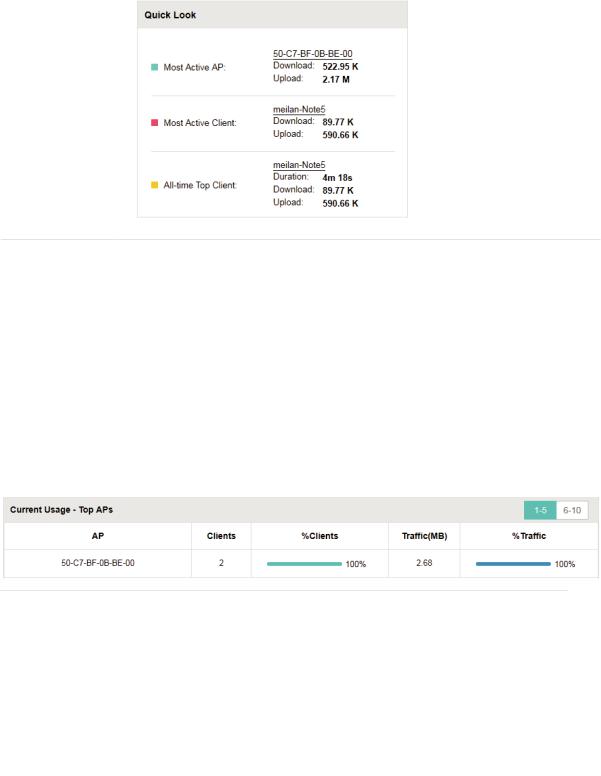
|
Most Active AP |
The current connected AP with the maximum traffic. |
|
|
|
|
|
|
Most Active |
The current connected client with the maximum traffic. |
|
|
Client |
|
|
|
All-time Top |
The client with the maximum traffic among all the clients that have ever accessed the |
|
|
Client |
EAP network. |
|
2.2.3 View Current Usage-Top EAPs
This tab lists the number of connected clients and the data traffic condition of the ten APs that use the most traffic currently.
|
Clients |
The amount of clients connected to this EAP. |
|
|
|
|
|
|
%Clients |
The proportion of current connected clients to the Top EAPs' total client |
|
|
|
amount. |
|
|
Traffic (MB) |
The total amount of data transmitted by this EAP, which equals the sum of the |
|
|
|
transmission traffic of all the current clients that connect to the AP. |
|
|
%Traffic |
The proportion of the EAP's current data transmission amount to the Top EAPs' |
|
|
|
total transmission amount. |
|
2.2.4 View Recent Activities
The Recent Activities statistics can be toggled between a view for the past specific 24 hours and one for the past specific 30 days.
The left ordinate axis indicates the traffic and the right one represents the number of the clients. The abscissa axis shows the selected time period. Traffic indicates a visual graph of the network
19

traffic during the selected time period. Client indicates a visual graph of the number of the connected clients during the selected time period. For example, the statistics information at 15:00 indicates the traffic size and client number from 14:00 to 15:00. In the following figure, at 11 o’clock, the traffic is about 3MB and there is 2 clients connected to the AP.
2.3 Monitor and Manage the EAPs
OC200 can discover all the EAP devices currently connected to the network and display the information of them on the Access Points page.
2.3.1 Manage the EAPs in Different Status
According to their connection status, EAPs are divided into four categories: connected, disconnected, isolated and pending. You can view the EAPs in different status on different pages:
|
|
|
|
|
|
|
|
|
|
|
|
|
All |
Displays the information of all EAPs in different status. |
|||
|
|
|
|
||
|
Connected |
Displays the connected EAPs. |
|||
|
|
|
The status of connected EAPs includes two cases: Connected and Connected |
||
|
|
|
(Wireless). |
||
|
|
|
Connected: After you adopt a wired EAP in Pending status, its status will become |
||
|
|
|
Provisioning, then Configuring and Connected eventually. |
||
|
|
|
Connected (Wireless): In a mesh network, if an EAP has a successful wireless uplink, |
||
|
|
|
its status will become Adopting (Wireless) and then Connected (Wireless). |
||
|
|
|
Only connected EAPs can be managed. A connected EAP will turn into a pending one |
||
|
|
|
after you forget it. You can refer to Forget this AP to forget an EAP or click Forget All |
||
|
|
|
on the page to forget all the connected EAPs. |
||
20

|
Disconnected |
Displays the disconnected EAPs. |
|
|
|
If a connected EAP powers off or disconnects from the OC200, it will be in |
|
|
|
Disconnected status. When a disconnected EAP is reset to factory defaults or forgot, |
|
|
|
it will turn into a pending one again. You can refer to Forget this AP to forget a EAP or |
|
|
|
click Forget All on the page to forget all the disconnected EAPs. |
|
|
Isolated |
Displays the isolated EAPs. |
|
|
|
In a mesh network, when the EAP which has been managed before by OC200 connects |
|
|
|
to the network wirelessly and cannot reach the gateway, it goes into the Isolated |
|
|
|
state. The isolated EAP searches for wireless uplink and the LED on the device turns |
|
|
|
green and flashes off every 5 seconds. To know more about mesh network, refer to |
|
|
|
Configure Mesh. |
|
|
Pending |
Displays the pending EAPs. |
|
|
|
The status of pending EAPs includes three cases: Pending, Pending (Wireless) and |
|
|
|
Managed by others. |
|
|
|
Pending: All the EAPs with wired network connection are in pending status by default |
|
|
|
when first discovered by OC200. |
|
|
|
Pending (Wireless): The factory default EAP with mesh functions and no wired network |
|
|
|
connection is in Pending (Wireless) status when first discovered by OC200. |
|
|
|
Managed by others: An EAP is located on the same network as the OC200, but has |
|
|
|
been already managed by an existing Omada controller before. You can provide the |
|
|
|
username/password to unbind the EAP from the existing controller and begin adoption |
|
|
|
in current controller. |
|
|
|
Only after pending EAPs are adopted and connected, you can manage them. To adopt |
|
|
|
pending EAPs, refer toAdopt the EAPs. |
|
2.3.2 View the Detailed Information of EAPs
You can click Overview, Config,Performance or Mesh Network tab to view different detailed information of EAPs.
|
|
|
|
|
|
|
|
|
|
|
Overview |
Displays the EAP's name, MAC address, IP address, status, model, hardware version, |
||
|
|
firmware version, number of connected clients and download/upload bytes. |
||
|
|
|
|
|
|
Config |
Displays the EAP’s name, MAC address, IP address, status, model, hardware version, |
||
|
|
firmware version, WLAN Group bounded with the 2G and 5G of the EAP, and radio of |
||
|
|
the 2G and 5G. |
|
|
|
Performance |
Displays the EAP’s name, MAC address, IP address, status, model, hardware version, |
||
|
|
firmware version, number of connected 2G clients and 5G clients, TX(Downloaded |
||
|
|
Traffic), RX(Uploaded Traffic), TX 2G and TX 5G. |
|
|
|
Mesh Network |
Displays the EAP’s name, MAC address, IP address, status, model, hardware version, |
||
|
|
firmware version, number of connected clients, hops, uplink APs and downlink APs. |
||
21
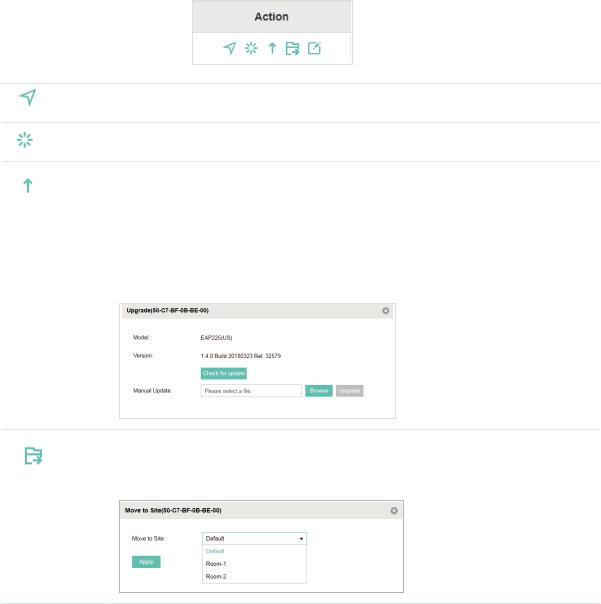
2.3.3 Manage the EAPs in the Action Column
You can execute the corresponding operation to the EAP by clicking an icon in the Action column.
Locate the EAP in the map.
Reboot the EAP.
Upgrade the EAP.
You can click Check for upgrade to detect if the current firmware is the latest version. The latest firmware for the EAP can be detected by the controller automatically. And you can upgrade the EAP online.
Click Browse to locate and choose the upgrade file in your computer, then click Upgrade to install the latest EAP firmware. The Status will appear as Upgrading until the process is complete and the EAP reconnects to the OC200.
Move the EAP to a site.
Select a site that has been created and click Apply. You can group all the EAPs by this way and centrally manage them on each site.
22
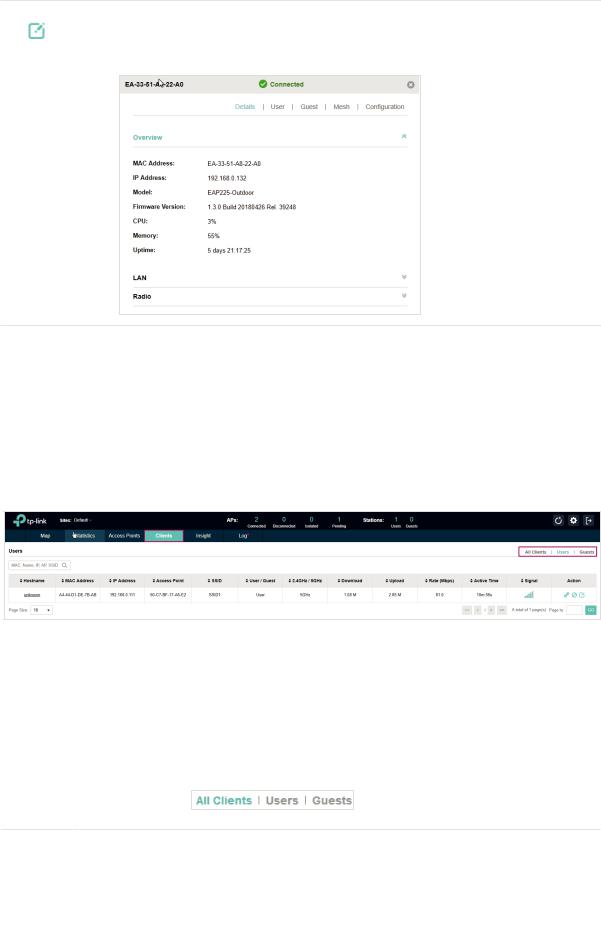
Configure the EAP.
For detailed instructions about how to configure the EAP on this window, refer to
Configure the EAPs Separately.
Note
··Only managed EAPs can be rebooted or upgraded.
··The EAP which is managed by the OC200 can not be logged in to its own management interface. To log in to the EAP’s own management interface, forget the EAP first.
2.4 Monitor and Manage Clients
The Clients tab displays the clients connected to the EAP network.
2.4.1 View the Current Information of Clients
The clients are divided into two types: User and Guest. Users are the clients connected to the EAP wireless network without the Portal Authentication. Guests are the clients connected to the EAP wireless network with the Portal Authentication.
You can click the following tabs to respectively view the detailed information of users and guests.
|
All Clients |
The page displays the information of all clients including users and guests. |
|
|
|
|
|
|
Users |
The page displays the information of Users. |
|
|
|
|
|
|
Guests |
The page displays the information of Guests. |
|
|
|
|
|
23
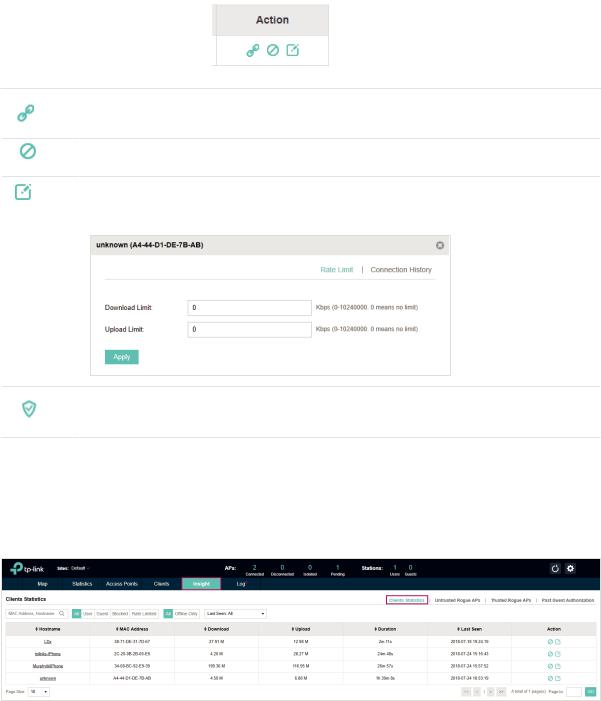
2.4.2 Manage Clients in the Action Column
You can execute the corresponding operation to the EAP by clicking an icon in the Action column:
Reconnect the client to the network.
Restrict the client's access to the network.
Configure the rate limit of the client and view the connection history.
Enter the download limit and upload limit and click Apply.
If the client is a Guest, you can click this icon to cancel the authorization for it.
2.5 View Clients Statistics During the Specified Period
The Clients Statistics page under the Insight tab displays the information of clients that have connected to the EAPs network during a specified period.
2.5.1 Select a Specified Period
Select a period from the drop-down menu. Then the page will display clients that have connected to the EAPs network during the period.
24
